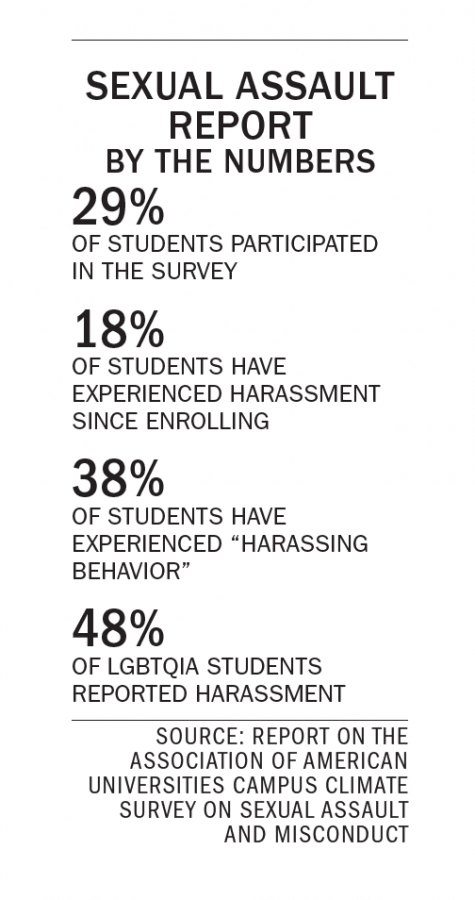Awareness surrounding sexual assault reporting and resources has increased among University of Minnesota students, according to recent survey data.
Earlier this month, the Association of American Universities released its second comprehensive report of sexual assault data from 33 colleges and universities across the U.S. The University was one of several Big Ten institutions to take part.
About 29 percent of degree-seeking students at the University of Minnesota — almost 13,000 students — participated this year, nearly double the rate of participation in the first survey in 2015.
While school officials said some data in the survey is troubling, trends relating to student attitudes of sexual assault are a positive sign.
“We need to recognize and maintain appropriate boundaries in the classroom and lab, in office spaces and co-curricular activities,” said Karen Hanson, University executive vice president and provost in a statement. “Both academic success and personal well-being are threatened by sexual harassment, so we have a special responsibility to see to it that our University is free from this sort of behavior.”
Between undergraduate and graduate and professional students, 63.7 percent said they believed it was “very or extremely likely” that campus officials would take a report of sexual assault or misconduct seriously. But students reporting this trust were more likely to be men, with undergraduate males reporting this response at 74.1 percent compared to 50.6 percent of their female peers.
Graduate students also gave differing responses to this question, with 62 percent of women reporting “very or extremely likely” compared to 78 percent of men.
About half of all respondents said that “it is very or extremely likely” that an investigation into these allegations would be “fair.”
Of the almost 14 percent of students who reported witnessing an event that could lead to sexual assault, more than 75 percent said they took action.
Of the approximately 23 percent of respondents who reported noticing a situation where someone was acting in a way that made other feel “uncomfortable or offended,” more than 65 percent said they took some type of action.
More than 18 percent of University students have experienced harassment since enrolling, or behavior or comments that negatively impacted the respondent’s daily functioning. More than 38 percent have experienced “harassing behavior,” or behavior that did not disrupt the respondent’s daily life.
Statistics in these areas consistently differ for members of the LGBTQ community, with more than 48 percent percent of LGBTQ students reporting harassment. Forty percent reported that it is “very or extremely likely” that campus officials would take their reports of sexual assault or misconduct seriously.
“The national research does say that disproportionately student folks with marginalized social identities such as sexual orientation, racial Identity or disability are disproportionately impacted by sexual violence than their counterparts with privilege,” said Katie Eichele, director at the Aurora Center for Advocacy and Education. “That’s something I want to tease out, especially if we’re trying to address campus climate issues and address a sense of warming and inclusiveness on campus.”
While sexual assault and misconduct remain prevalent on campuses across the U.S., students everywhere are more aware of the issue than they were in 2015, according the report.
This remains true at the University campus too. According to the survey, around 88 percent of incoming students said they had completed some sort of training regarding sexual misconduct, a substantial increase from 2015.
Across the Big Ten
The University is one of several Big Ten schools to gather its information this way, along with the University of Michigan, Northwestern University, Ohio State University and the University of Wisconsin-Madison. According to University of Minnesota spokesperson Caitlin Hurley, the University takes part in the AAU survey in an effort to promote long-term culture change.
“The Twin Cities campus takes part in the survey because it assists in informing the University’s efforts to prevent and respond to sexual assault and other misconduct,” Hurley said.
The other Big Ten schools either use their own surveys or some other third party in order to suit their individual needs.
The University of Iowa uses the Administrator-Researcher Campus Climate Collaborative survey, a third-party survey developed in February 2015.
“The University’s campus climate survey on sexual misconduct committee felt the ARC3 [survey] was the most comprehensive survey available,” said Anne Bassett, a University of Iowa spokesperson in a statement.
Michigan State University is one Big Ten school that uses its own survey, which includes responses from both faculty and students.
Michigan State University’s press office said in a statement that the school believes this approach allows for more comprehensive data.
“We wanted to go beyond the information AAU collects,” the statement read.








